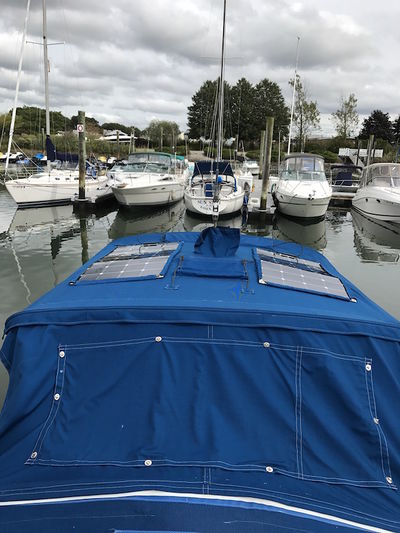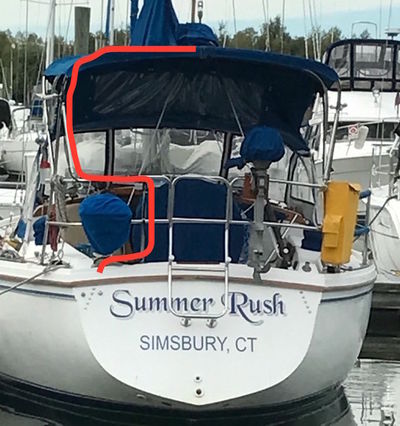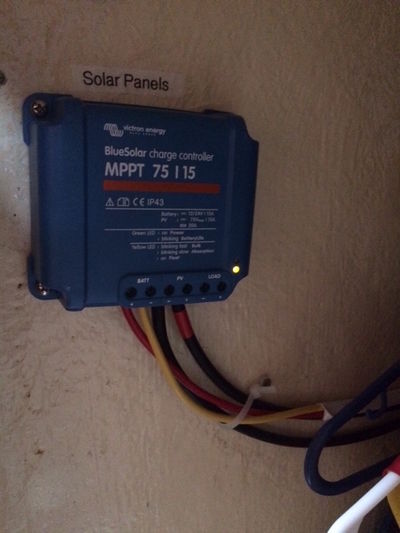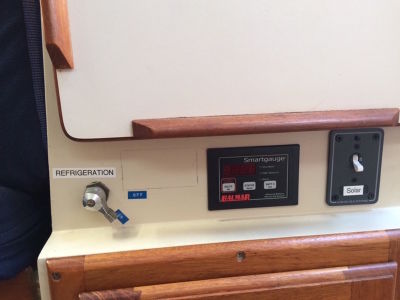Flexible solar panels
This summer as we got ready to go on a 2 week cruise, we decided that it was time to add some solar panels to our boat and save a few bucks on marina fees. I think we came close to breaking even on the cost as marina fees in the northeast can run $120-$150 a night.
The cost of building a frame for a rigid panel was putting the panels out of reach for us plus the construction seemed complex. We decided that flexible solar panels were the way to go. We did a lot of research on which panels to get that were a balance of cost and quality as well as research on the solar controller. Our boat - a 1987 MK1 tall rig has the now typical 4 - 6V golf cart battery configuration for a total of 460 AH. We have updated all the interior lighting to LED as well as our anchor light. In general our electricity usage is mostly due to the refrigeration which later in the summer we realized was not running well due to a poor connection of the thermostat and a failed cooling fan on the condenser unit but despite that we were able to manage with the new set up for 10 days on the hook.
In the end we chose HQST branded panels. They came well reviewed and the company is in the US and was very good to work with. They sell the panels on Amazon but I ordered them directly from the company to expedite the shipping.
The following is the list of all the items we needed for our install as well as where we sourced them from and their cost as of July 2016. This install took us about half a day plus a few hours for me to sew the velcro to the bimini. This list includes some tools we needed to make the connections
| Solar Panel items | Source | Cost |
|---|---|---|
| Signstek MC3 MC4 Solar Crimping Tools for 2.5-6.0mm2 Solar Panel PV Cable | Amazon | $19.99 |
| 2 - HQST 100 Watt 12 Volt Monocrystalline Flexible Solar Panels | HQST or Amazon | $371.98 |
| RENOGY® Branch Connectors Solar MC4 Connectors Y connector in Pair MMF+FFM | Amazon | $12.99 |
| Victron BlueSolar 75/15 MPPT Charge Controller - 15 Amps / 75 Volts | Amazon | $98.29 |
| Blue Sea Systems A-Series White Toggle Circuit Breaker - Single Pole | Amazon | $11.38 |
| RENOGY® 5 Pair MC4 Male/ Female Solar Panel Cable Connectors Double Seal Rings for Better Waterproof Effect | Amazon | $9.99 |
| RENOGY MC4 Assembly Tool | Amazon | $6.99 |
| Sewell Solar Panel PV Cable UL Rated, 10 AWG, 100 ft. Roll | Amazon | $54.95 |
| Blue Sea Systems Mounting Panel for Toggle Type Magnetic Circuit Breakers Panel Blank Single A-Series | Amazon | $14.99 |
| Various velcro strips -21 feet 1" and 5/8" inch | Defender | $31.71 |
| 20 ft Ancor Marine Grade Flat Duplex Safety Electrical Cable - 10/2 | Defender | $27.8 |
| Scanstrut Cable Clam / Deck Seal | Defender | $18.99 |
| Total cost | $680.05 |
Here is a photo of the finished product

We decided to do this project on a Sunday afternoon and only had 1 week before we left on the cruise so we chose sources for the items that could get to us here in CT within a few days. Amazon prime and Defender which ships overnight to me in CT were our best options and generally were the best price. The longest delivery time was the actual solar panels. Since we decided to use a sewn in velcro attachment method to attach the panels to the bimini and I needed to get that done before the panels arrived, I made a cardboard mockup of the panels per the manufacturers specifications.
Here is how we did the work.
- Make the cardboard mockup of the panels and determine the positioning on the top of the bimini
- Make strips of Sunbrella that will be sewn into the bimini
- Sew velcro onto the strips of sunbrella
- Sew the strips of Sunbrella to the bimini
- Sew additional strips of velcro to the bimini along where the edges of the panels will sit.
- I made a cover panel to protect the extra wire and connectors from the UV rays which I sewed onto the bimini top with some velcro edges.
- Determine the rough wiring path for the 2 solar panel wires - The path we took was along the port side. The wires run along and down the bimini frame, to the stern rail, along the rail to the top edge of the stern, through a hole into the aft cockpit lazarette, along the port side hull, above the fuel tank, into the head sink cabinet, in the space behind the area where the toilet is (behind the fiberglass) and into a hole in the far end of the hanging locker aft of the nav station.
- Install the Scanstrut Cable Clam / Deck Seal to make a waterproof connection where the wires run through the edge of the stern.
- We mounted the solar controller in the hanging locker - Since we wanted to be able to see the lights on the controller we positioned this toward the front of the locker.
- Next we ran the regular electrical wires from the controller to the other side of the hanging locker so that they came out behind the electrical panel. We have other items run along this path so there was already a hole in the correct position.
- The electrical wires then run down the port side settee, along side the holding tank and down under the floor to the cabinet under the galley sink.
- We then installed a circuit breaker switch just under the little fold down table in the galley area - This switch allows us to turn off the power coming from the solar panels - this is the recommendation when connected to shore power so that you don't confuse your battery charger when both shore and solar power are feeding the batteries.
- From the switch we then wired into the battery compartment and to the battery bus bars.
- Attach sticky back velcro to the edges of both the top and bottom of the solar panels
- Place the panels on the bimini and adhere with the velcro
- Use the Renology assembly tools to help make the MC4 connections to the solar panel wires- Note there are lots of videos on YouTube on how to make these connections that are very helpful
- Make 2 pigtails and Install the branch connectors to these - The 2 panels are installed in parallel which required us to use 2 branch connectors to combine the positives of the 2 panels together and the negatives of the 2 panels together.
- Connect all the MC4 connectors together
- Insert the solar wires into the controller
- Complete any other electrical connections
- Tidy up the wires along the whole path with some zip ties
- Unplug the shore power and let the sun do its work!
Note: There are other methods of attaching these flexible solar panels to the bimini. Another option is to add a reinforcement patch with a grommet to your bimini at the corners where the panels will be. The panels have grommets in the corners and you could simply use zip ties to fasten the two.
Note: We used a clamp on style electrical gauge around each wire to test and make sure each panel was generating current individually. Each panel can generate 5.7 AMPS optimally and we saw between 4 and 5.5 at any given time on a sunny day depending on the angle of the sun.



